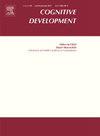父亲、母亲和幼儿在最喜欢的活动中的空间谈话:与性别、主导语言和活动选择的联系
IF 1.8
3区 心理学
Q3 PSYCHOLOGY, DEVELOPMENTAL
引用次数: 0
摘要
日常活动——搭积木塔、摆桌子、穿衣服——为幼儿提供了许多学习空间概念的机会。父母与幼儿共同参与这些活动,使用空间语言,是对幼儿空间认知的支持。我们对美国讲英语和西班牙语的父亲、母亲和幼儿(28名女孩,27名男孩;年龄24-36岁( 个月),在家中进行“最喜欢的活动”。我们描述了父亲和母亲使用空间语言的特征(即空间关系、空间特征、数量级/比较和空间动词),将亲子对的活动选择分为空间和非空间两类,并测试了活动选择是否与父母使用空间语言有关。空间词出现频率高,个体父母差异很大。空间谈话的总量没有因父母的主导语言、父母性别或孩子性别而异。然而,空间话语的具体类型因主导语言而异,父母为幼儿提供了独特的空间词汇。父母和孩子选择了各种各样最喜欢的活动,其中大约一半被归类为空间活动。虽然活动选择(即空间与非空间)与父母或子女的性别无关,但探索性分析揭示了一种趋势水平效应,表明父亲-男孩参与空间活动的比例是母亲-女孩的两倍。最重要的是,与幼儿进行空间活动的父亲比从事非空间活动的父亲产生更多的空间谈话;母亲选择的活动(空间或非空间)与她们的空间语言使用无关。本文章由计算机程序翻译,如有差异,请以英文原文为准。
Father, mother, and toddler spatial talk in a favorite activity: Associations with gender, dominant language, and activity choice
Everyday activities—building block towers, setting the table, getting dressed—offer numerous opportunities for toddlers to learn about spatial concepts. As parents jointly engage in such activities with their toddlers and use spatial language, they support toddlers’ spatial cognition. We video-recorded U.S. English- and Spanish-speaking fathers, mothers, and toddlers (28 girls, 27 boys; ages 24–36 months) during a ‘favorite activity’ at home. We characterized fathers’ and mothers’ use of spatial language (i.e., spatial relations, spatial features, magnitudes/comparisons, and spatial verbs), classified parent-toddler pairs’ activity choice as spatial vs. nonspatial, and tested whether activity choice related to parents’ use of spatial language. Spatial words were frequent, and individual parents varied substantially. Overall amount of spatial talk did not differ by parents’ dominant language, parent gender, or child gender. However, specific types of spatial talk varied by dominant language, and fathers and mothers provided their toddlers with unique spatial words. Parent-toddler pairs selected a wide variety of favorite activities, with approximately half classified as spatial. Although activity choice (i.e., spatial vs. nonspatial) did not relate to parent or child gender separately, exploratory analyses revealed a trend-level effect showing that twice as many father-boy as mother-girl pairs engaged in spatial activities. Most centrally, fathers who engaged in spatial activities with their toddlers produced more spatial talk than did fathers who engaged in nonspatial activities; mothers’ choice of activity (spatial or not) did not relate to their spatial language use.
求助全文
通过发布文献求助,成功后即可免费获取论文全文。
去求助
来源期刊

Cognitive Development
Multiple-
CiteScore
3.20
自引率
5.60%
发文量
114
期刊介绍:
Cognitive Development contains the very best empirical and theoretical work on the development of perception, memory, language, concepts, thinking, problem solving, metacognition, and social cognition. Criteria for acceptance of articles will be: significance of the work to issues of current interest, substance of the argument, and clarity of expression. For purposes of publication in Cognitive Development, moral and social development will be considered part of cognitive development when they are related to the development of knowledge or thought processes.
 求助内容:
求助内容: 应助结果提醒方式:
应助结果提醒方式:


